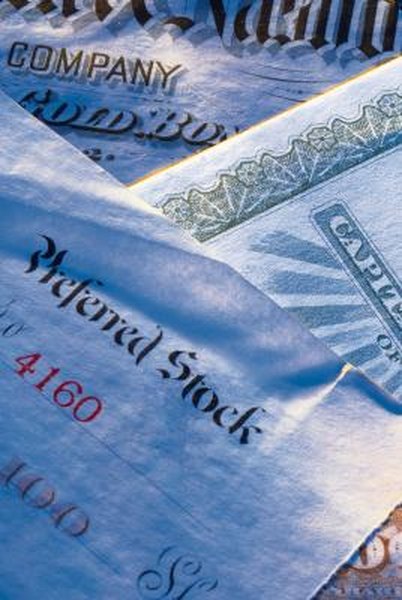How do I Convert Preferred Stocks to Common Stocks?
You can instruct your broker to exchange convertible preferred shares for common stock.
Comstock/Comstock/Getty Images
A corporation can raise money from investors by borrowing it or by issuing stock. While issuers of bonds must eventually repay the loans, stock is part of the ownership structure of the firm. Stock, with the exception of redeemable preferred stock, is perpetual -- once issued, it trades for the life of the issuing corporation. All corporations issue common stock, some issue preferred stock, and some preferred stock is convertible to common stock.
Common Stock
Common stock represents shareholder ownership of a corporation. An investor in common stock expects to participate in the growth of a company, through higher stock prices and/or dividends. Common stock prices usually rise when corporations generate increased earnings. They might also rise when a company buys back and retires some outstanding common stock, thereby lowering the supply of shares. Corporate boards may declare dividends on common stock, paid in cash or additional shares.
Preferred Stock
Preferred stock has bond-like features. It pays a high dividend that is similar to a bond’s yield. Prices of bonds and preferred stock are sensitive to interest rates. Neither bonds nor preferred shares participate in the earnings of a company -- their payouts remain fixed, even if the company grows. Preferred shares must pay all dividends before common stockholders can receive dividends. If a corporation liquidates, the proceeds first pay off bondholders, then preferred stockholders and finally, if any money is left, common stockholders. Redeemable preferred shares feature a maturity date, at which time the corporation retires the shares for a cash payment.
Convertible Preferred
A corporation may issue convertible preferred shares at a stated price, known as the parity value. Shareholders may convert these preferred shares to common shares in a predetermined ratio. This conversion ratio, when divided into the preferred share’s parity price, gives the conversion price -- the price the common stock must attain to make the conversion profitable. A corporation issues convertible preferred shares with a conversion price well below the current stock price.
Conversion Premium Percentage
After corporations issue convertible preferred shares, traders may buy and sell them in the secondary market. The value of the shares you obtain by converting a preferred share is equal to the common stock's market price multiplied by the conversion ratio. The conversion premium percentage is the difference between the preferred share’s parity value and its conversion value, divided by the parity value. Low conversion premiums make profitable conversions more likely. Common stock prices thus influence the prices of convertible preferred shares that have a low conversion premium percentage, whereas convertible preferred stock with a high conversion premium trades like a bond.
Example
Suppose XYZ Corp issues convertible preferred shares for $100 each and with a conversion ratio of 6.5 -- shareholders can convert one preferred share into 6.5 common shares. Dividing 6.5 into $100 gives a conversion price of $15.38. The common stock must reach this price to make conversion profitable. If the market price of XYZ common is $12, the conversion value of a preferred share is 6.5 times $12, or $78. The conversion premium percentage is the difference between the parity and conversion values divided by 100 -- or 22 percent in this example. If traders consider this a low conversion premium, the convertible preferred share prices will be very sensitive to the price of the common stock. In our example, once the common shares rise above $15.38, a convertible preferred shareholder can realize an immediate cash profit by instructing her broker to convert the preferred shares to common stock and then selling the stock. Your broker will handle all the details on your behalf.
References
Resources
Writer Bio
Eric Bank is a senior business, finance and real estate writer, freelancing since 2002. He has written thousands of articles about business, finance, insurance, real estate, investing, annuities, taxes, credit repair, accounting and student loans. Eric writes articles, blogs and SEO-friendly website content for dozens of clients worldwide, including get.com, badcredit.org and valuepenguin.com. Eric holds two Master's Degrees -- in Business Administration and in Finance. His website is ericbank.com.

